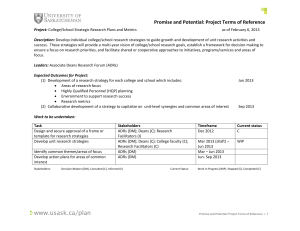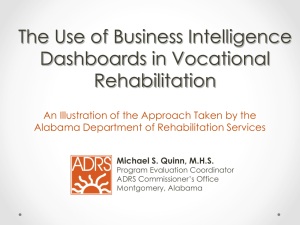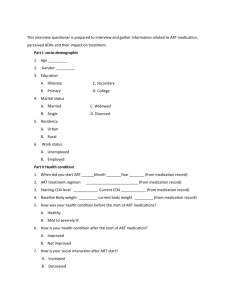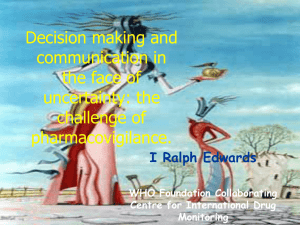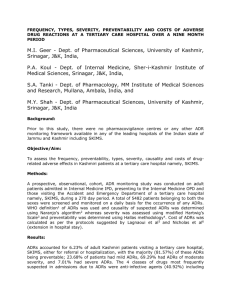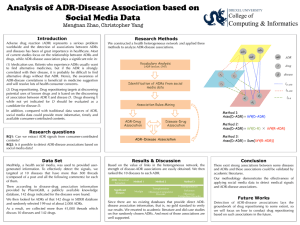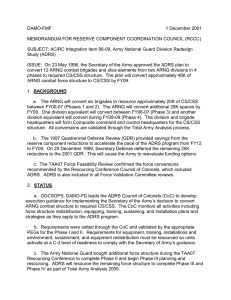Document 13309254
advertisement
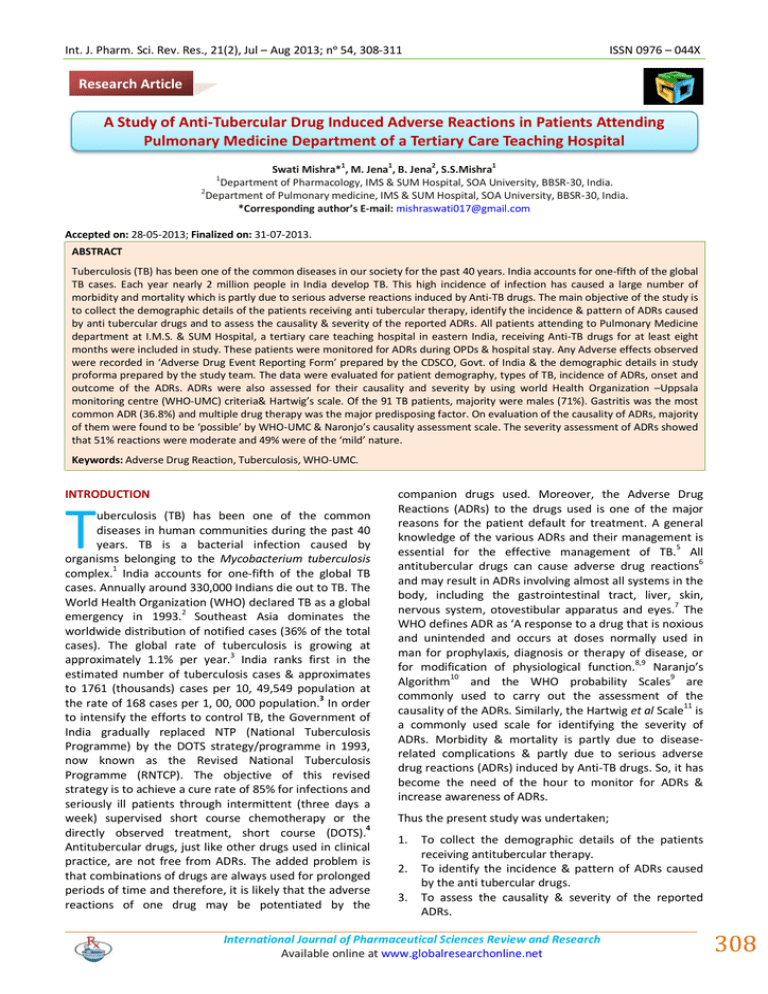
Int. J. Pharm. Sci. Rev. Res., 21(2), Jul – Aug 2013; nᵒ 54, 308-311 ISSN 0976 – 044X Research Article A Study of Anti-Tubercular Drug Induced Adverse Reactions in Patients Attending Pulmonary Medicine Department of a Tertiary Care Teaching Hospital 1 1 2 1 Swati Mishra* , M. Jena , B. Jena , S.S.Mishra Department of Pharmacology, IMS & SUM Hospital, SOA University, BBSR-30, India. 2 Department of Pulmonary medicine, IMS & SUM Hospital, SOA University, BBSR-30, India. *Corresponding author’s E-mail: mishraswati017@gmail.com 1 Accepted on: 28-05-2013; Finalized on: 31-07-2013. ABSTRACT Tuberculosis (TB) has been one of the common diseases in our society for the past 40 years. India accounts for one-fifth of the global TB cases. Each year nearly 2 million people in India develop TB. This high incidence of infection has caused a large number of morbidity and mortality which is partly due to serious adverse reactions induced by Anti-TB drugs. The main objective of the study is to collect the demographic details of the patients receiving anti tubercular therapy, identify the incidence & pattern of ADRs caused by anti tubercular drugs and to assess the causality & severity of the reported ADRs. All patients attending to Pulmonary Medicine department at I.M.S. & SUM Hospital, a tertiary care teaching hospital in eastern India, receiving Anti-TB drugs for at least eight months were included in study. These patients were monitored for ADRs during OPDs & hospital stay. Any Adverse effects observed were recorded in ‘Adverse Drug Event Reporting Form’ prepared by the CDSCO, Govt. of India & the demographic details in study proforma prepared by the study team. The data were evaluated for patient demography, types of TB, incidence of ADRs, onset and outcome of the ADRs. ADRs were also assessed for their causality and severity by using world Health Organization –Uppsala monitoring centre (WHO-UMC) criteria& Hartwig’s scale. Of the 91 TB patients, majority were males (71%). Gastritis was the most common ADR (36.8%) and multiple drug therapy was the major predisposing factor. On evaluation of the causality of ADRs, majority of them were found to be ‘possible’ by WHO-UMC & Naronjo’s causality assessment scale. The severity assessment of ADRs showed that 51% reactions were moderate and 49% were of the ‘mild’ nature. Keywords: Adverse Drug Reaction, Tuberculosis, WHO-UMC. INTRODUCTION T uberculosis (TB) has been one of the common diseases in human communities during the past 40 years. TB is a bacterial infection caused by organisms belonging to the Mycobacterium tuberculosis complex.1 India accounts for one-fifth of the global TB cases. Annually around 330,000 Indians die out to TB. The World Health Organization (WHO) declared TB as a global 2 emergency in 1993. Southeast Asia dominates the worldwide distribution of notified cases (36% of the total cases). The global rate of tuberculosis is growing at 3 approximately 1.1% per year. India ranks first in the estimated number of tuberculosis cases & approximates to 1761 (thousands) cases per 10, 49,549 population at 3 the rate of 168 cases per 1, 00, 000 population. In order to intensify the efforts to control TB, the Government of India gradually replaced NTP (National Tuberculosis Programme) by the DOTS strategy/programme in 1993, now known as the Revised National Tuberculosis Programme (RNTCP). The objective of this revised strategy is to achieve a cure rate of 85% for infections and seriously ill patients through intermittent (three days a week) supervised short course chemotherapy or the directly observed treatment, short course (DOTS).4 Antitubercular drugs, just like other drugs used in clinical practice, are not free from ADRs. The added problem is that combinations of drugs are always used for prolonged periods of time and therefore, it is likely that the adverse reactions of one drug may be potentiated by the companion drugs used. Moreover, the Adverse Drug Reactions (ADRs) to the drugs used is one of the major reasons for the patient default for treatment. A general knowledge of the various ADRs and their management is essential for the effective management of TB.5 All antitubercular drugs can cause adverse drug reactions6 and may result in ADRs involving almost all systems in the body, including the gastrointestinal tract, liver, skin, 7 nervous system, otovestibular apparatus and eyes. The WHO defines ADR as ‘A response to a drug that is noxious and unintended and occurs at doses normally used in man for prophylaxis, diagnosis or therapy of disease, or for modification of physiological function.8,9 Naranjo’s 10 9 Algorithm and the WHO probability Scales are commonly used to carry out the assessment of the 11 causality of the ADRs. Similarly, the Hartwig et al Scale is a commonly used scale for identifying the severity of ADRs. Morbidity & mortality is partly due to diseaserelated complications & partly due to serious adverse drug reactions (ADRs) induced by Anti-TB drugs. So, it has become the need of the hour to monitor for ADRs & increase awareness of ADRs. Thus the present study was undertaken; 1. 2. 3. To collect the demographic details of the patients receiving antitubercular therapy. To identify the incidence & pattern of ADRs caused by the anti tubercular drugs. To assess the causality & severity of the reported ADRs. International Journal of Pharmaceutical Sciences Review and Research Available online at www.globalresearchonline.net 308 Int. J. Pharm. Sci. Rev. Res., 21(2), Jul – Aug 2013; nᵒ 54, 308-311 PATIENTS AND METHODS A prospective, observational clinical study was carried out for eight months (March - October 2012) in pulmonary medicine department in collaboration with Dept. of pharmacology of our hospital. All the patients of tuberculosis were enrolled after taking their informed consent & monitored for ADRs. Patient profile was maintained to identify the patient demography, type of treatment, disease classification, date of start & completion of treatment, record of follow-up, types of TB, incidence of ADRs, onset, management and outcome of the ADRs. Any adverse effects observed were recorded in the ‘Adverse Drug Event Reporting Form’ prepared by the CDSCO, Govt. of India. ADRs were also assessed for their causality and severity as per the standard algorithms. 91 cases were studied for ADR monitoring during the study period and causality was assessed using world Health Organization –Uppsala monitoring centre (WHO-UMC) & Naronjo’s causality assessment scale. Severity was assessed by Hartwig’s questionnaire. OBSERVATION AND RESULTS A total number of 91 patients who were on DOTS therapy were included in our study, of which 65 patients i.e around 71% were male & 26(28.6%) were female. 48 patients were under 36 years of age (52.7%) followed by 32 resides in the age of 36 – 65 (35.2%). Rest were in more than 65 years age group (12.1%) (Table 1). The patients of TB in the study were divided according to their type of TB, like pulmonary (88/96.7%) & extra pulmonary (3/3.3%). Table 1: Demographic Profile of patients receiving Anti tubercular drugs (n=91) Parameters Gender Age group (in years) Type of TB Type of DOTS Number Percentage (%) Male 65 71 Female 26 29 Under 36 48 52.7 36-65 32 35.2 More than 65 11 12 Pulmonary 88 96.7 Extra pulmonary 3 3.3 Category I 40 44 Category II 51 56 Out of these 91 patients only 15 patients developed 19 ADRs of various types (Table 2). Among the 19 reported ADRs, most were observed in males (15/78.9%) & remaining (4/21.1%) were females. Out of 19 ADRs, 10 (57%) were from patients on Category II of the DOTS therapy, followed by 9 (43%) from Category I. The overall incidence of ADRs was 20.87%. ADRs in this study were categorized according to the systems affected like gastrointestinal system, skin, nervous system & other systems like vestibular, muscle etc. Majority of ADRs were ISSN 0976 – 044X related to gastrointestinal system (8 cases) followed by central nervous system (4 cases), other systems (5 numbers) & 2 cases of skin eruption (Figure 1). Gastritis was the most common ADR (36.8%) followed by skin reaction & peripheral neuropathy (10.52%). In 87.1% of the cases, the suspected drug was continued in spite of the ADR, without any complications. Two (10.52%) of the ADRs occurred on the first day of the treatment. 6 ADRs (36.8%) occurred within a week of treatment, 5 (28.57%) in the second week, 3 (16.28%) in the third week & 1(5.26%) in each following weeks of the initiation of anti tubercular therapy. Out of the 19 cases, dechallenge of the suspected drug was done in 1 (5.26%) case and definite improvement was observed. On evaluation of the causality of ADRs, a majority of them were found to be ‘possible’ by both WHO-UMC and Naranjo’s scales. The reported ADRs were classified into different levels like mild, moderate or severe based on the Modified Hartwig and Siegel scale. The severity assessment of ADRs showed that 51% reactions were moderate and 49% were of the ‘mild’ nature as per the Hartwig et al scale. DISCUSSION Out of 91 patients enrolled in the study, 15 patients developed 19 ADRs (20.87%). The highest numbers of ADRs [15 (78.94%)] were observed in males which is in contrast to the study by Yee & Shakya et al12 who considered female gender as a risk factor for the occurrence of ADRs due to anti-TB drugs. But in the study, by D.K.Tak et al13, males developed more ADRs, which could be due to majority of males included in the study. In our study, 48 patients were under 36 years of age (52%) followed by 32 resides in age of 36-65 (36%) & eleven were in more than 65 years age group (12%). This result is in contrast to the study by Yee et al12 where age over 60 years was associated with increased incidence of ADRs due to anti TB drugs. A study conducted by Daphne et al 13 showed that ADRs due to anti tubercular drugs occurred in patients above the age of 60 years. But in the present Study, majority of ADRs were observed in patients below 60 years of age. In our study 9 (47%) ADRs were observed in age group of less than 36 years & 36-65 years. 10 ADRs (57%) were from patients on Category II of the DOTS therapy, followed by 9 (43%) from Category I. Two (10.52%) of the ADRs occurred on the first day of the treatment. 6 ADRs (36.8%) occurred within a week of treatment, 5 (28.57%) in the second week, 3 (16.28%) in the third week & 1(5.26%) in each following weeks of the initiation of antitubercular therapy. Out of the 19 cases, dechallenge of the suspected drug was done in 1 (5.26%) case & definite improvement was observed. The highest reported ADR was gastritis (36.8 %) 15 which is in accordance to the study by Dhingra et al , where it was around 53%. Peripheral neuropathy, characterized by a tingling and burning sensation in the nd hands, feet & skin reaction (Figure-2) was 2 most common ADRs observed in our study population, whose International Journal of Pharmaceutical Sciences Review and Research Available online at www.globalresearchonline.net 309 Int. J. Pharm. Sci. Rev. Res., 21(2), Jul – Aug 2013; nᵒ 54, 308-311 occurrence was comparable to that found in the study conducted by Dhingra et al, 15 where it was around 17%. On evaluation of the causality of ADRs, a majority of them were found to be ‘possible’ by both WHO-UMC and Naranjo’s scales. The reported ADRs were classified into ISSN 0976 – 044X different levels like mild, moderate or severe based on the Modified Hartwig and Siegel scale. The severity assessment of ADRs showed that 51% reactions were moderate and 49% were of the ‘mild’ nature as per the Hartwig et al scale. Table 2: Incidence of ADRs in different systems (n=19) Systems affected by ADR Gastrointestinal Skin Nervous system Others Type of ADRs Number Percentage (%) Hepatitis 1 5.26 Gastritis 6 36.8 Anorexia 1 5.26 Skin reactions 2 10.52 Peripheral neuropathy 2 10.52 Dizziness 1 5.26 Psychosis 1 5.26 Ototoxicity 1 5.26 Vertigo 1 5.26 Weakness 2 10.52 Arthralgia 1 5.26 Figure 1: ADRs in different systems Limitations and future implications of the study Figure 2: Anti tubercular drug induced acneform eruptions. Use of anti-tubercular drug use is safe, but regular monitoring is required to prevent ADRs at the initial stage. Majority of the patients seem to have mistaken the symptoms of ADR to be due to the disease being treated. The study concluded that there is need of a system for proper monitoring for ADRs due to anti tubercular drugs. Small sample size, confined to a single hospital only, a short Period of follow up & inability to rechallenge are the other limitations. Yet the study clearly provides the baseline data for comparing similar studies at the level of state, country and the world. It also provides the information regarding the management of the adverse drug reactions and their outcome thus making the drug therapy safer and more rational. This study has added up International Journal of Pharmaceutical Sciences Review and Research Available online at www.globalresearchonline.net 310 Int. J. Pharm. Sci. Rev. Res., 21(2), Jul – Aug 2013; nᵒ 54, 308-311 ISSN 0976 – 044X in the direction of strengthening the activity of pharmacovigilance in this part of the country. 6. Bedi RS, Pyrazinamide- inducedhypersensitivity reaction, Indian Journal of Tuberculosis, 37, 1990, 41. CONCLUSION 7. Tandon. RK, Garg PK, Antituberculosistreatment induced hepatotoxicity. In:Sharma. S K, Mohan, Tuberculosis. New Delhi: Jaypee Brothers, 2004, 500. 8. Edwards IR, Aronson JK, Adverse drug reactions: definition; diagnosis and management. Lancet, 356, 2000, 1255-1259. 9. Parthasarthi.G, Karin N, Milap C Nahata, A Text of Clinical st Pharmacy Practice, Essential Concepts of Skills, 1 Edition, Orient Longman, India, 2001, 84-97. Anti tubercular drugs, just like other drugs used in clinical practice, are not free from ADRs. They may cause significant reactions both in severity & quantity leading to abstinence from therapy, prolonged hospital stay &even death. In our study, the number of ADRs was high in males. Gastritis was the most common ADR and multiple drug therapy being the major predisposing factor. Majority of the ADRs reported in this study were categorized as ‘possible‘& mild to moderate severity. In majority of the cases, the suspected drug was continued in spite of the ADRs, without any complications. Counselling of patients for timely prevention, detection and management of ADRs was also highly suggestive. REFERENCES 1. Bennet PN, Brown MJ, Clinical pharmacology, Edinburgh: Churchill Livingston, 9, 2003, 237- 255. 2. Nehaul LK. Tuberculosis. In: Walker R, Edwards C, eds. Clinical Pharmacy and Therapeutics. Edinburgh: Churchill Livingston, 3, 2003, 583-595. 3. Maher D, Raviglione M, Global Epidemiology of Tuberculosis, Clinics in Chest Medicine, 26, 2005, 167-182. 10. Naranjo CA, Busto U, Sellers EM, A method of Estimating the probability of Adverse Drug Reactions, Clin Pharm Ther 30, 1981, 239-45. 11. Hartwig SC, Sieegel JJ, Schneider PJ, Preventability and severity assessment in Reporting Adverse Drug Reactions, Am J Hosp Pharm, 49, 1992, 2229-2232. 12. Yee D, Valiquette C, Pelletier M, Parisien I, Rocher I, Menzies D, Incidence of serious side effects from first- Line antitiberculosis drugs among patients treated for active tuberculosis, Am J Respir Crit Care Med, 167, 2003, 14721477. 13. Tak D.K.et al., Safety Evaluation Of Antitubercular Therapy Under Revised National Tuberculosis Control Programme In India, JCDR, 3, 2009, 1395-1401. 4. Tripathi K.D., Antitubercular drugs, Essentials of Medical harmacology, New delhi: Jaypee Brothers, 2003, 705-708. 14. Daphne Y, Marthe P et al., Incidence of serious side effects from First-line antituberculosis drugs among patients treated for Active Tuberculosis, Am J Resp Crit Care Med, 167, 2003, 1472-1477. 5. Devi S, Ramchandran R, Santha S, Adversereaction to antituberculosis drugs and theirmanagement, Bulletin, 4(3, 4), 1997. 15. Dhingra VK, Rajpal S, Aggarwal N, Aggarwaln JK, Shadab K, Jain SK, Adverse drug reactions observed during DOTS, J Commun Dis, 36, 2004, 251-259. Source of Support: Nil, Conflict of Interest: None. International Journal of Pharmaceutical Sciences Review and Research Available online at www.globalresearchonline.net 311
